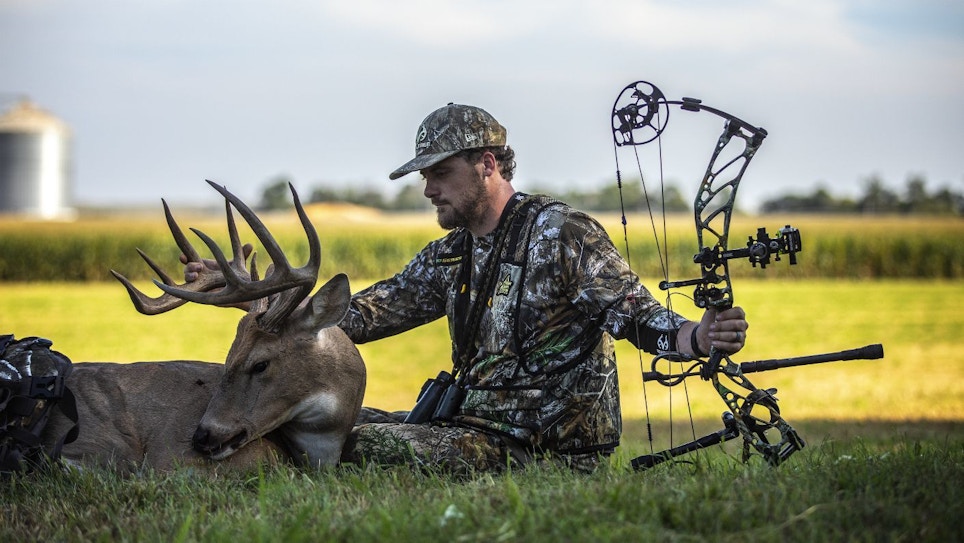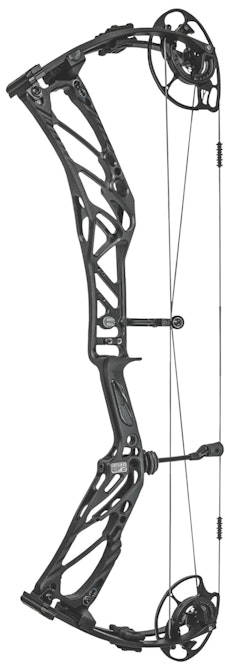Not so many years ago, bow design was all about achieving maximum efficiency, i.e., speed. In more recent years, it’s been mostly about a smooth draw cycle and a quiet, vibration-free shot. Now a new trend seems to be emerging: easy tunability.
The Elite Kure is a case in point. Elite has built a sizeable following by designing bows that are reasonably fast and very pleasant to shoot. The Kure reflects that legacy but adds easy tuning to the mix. This is a big deal. Those of us who have been shooting compound bows for more than a decade or so remember when tuning a bow was arcane, time-consuming, frustrating, blending science, art and voodoo. Entire books were written on the subject, and the mechanical broadhead probably owes its existence to the difficulty of tuning a bow. In more recent years, significantly improved strings and better bow designs decreased the mystique. However, tuning still usually requires multiple minute adjustments to an arrow rest or pressing a bow and twisting or untwisting cables, often repeating the process numerous times until the perfect tune is achieved. Or not.
Easy tunability obviously benefits those shooters who don’t own bow presses or who lack the technical knowledge to tune a bow to perfection. Even the most technically proficient shooter can appreciate time-saving convenience and the ability to make minor adjustments in the field or on the range. Twisting cables or strings is not an ideal solution to tuning problems since bows and strings are designed to perform at their peak with a given amount of twist. Elite calls its new technology S.E.T. (Simplified Exact Tuning). It allows the shooter, using only a Torx wrench, to make micro-adjustments to the pitch of the limbs and the attitude of both cams at the limb pockets. The process is user-friendly. The adjustment screws are labeled “tear right” and “tear left,” indicating the direction to turn the screw to make the proper adjustment when paper tuning.
The new Asym Tri-Track Cams are noteworthy for more than their tunability. Still synchronized and designed to retain the smooth feel for which Elite is known, they are a departure from Elite’s previous two-track cam systems. Among other things, the design changes allow for a modular draw-length system adjustable without a press over a range of 23 to 30 inches, along with cable stops, an optional limb stop and a let-off adjustable from 90% down to 70%. Draw length, by the way, is adjustable in one-quarter-inch increments, as opposed to the standard one-half-inch increments. Since a one-quarter-inch draw length change can be the difference between a rock-steady hold and a sight pin doing figure eights, this feature — almost as much as the tunable cams — can save time and frustration.
Also new on this cam is an optional limb stop. The bow comes standard with adjustable cable stops, which move with the draw length. Easy-to-install limb stops are provided for shooters who prefer that rock-solid back wall. They can be adjusted to hit the limb slightly after the cable stops for a very customizable feel at full draw.
Limbs are wider than on Elite’s previous models, and new limb dampeners have been added to the mix as well. What’s not so new? The riser is still identifiably Elite, but the grip has been tweaked. The tunable roller guide is back; the importance of the tuning function is significantly reduced given the S.E.T. feature, but it still allows for optimum fletching clearance to keep any torque to a minimum.
The test bow was Ninja Black, and fit and finish was durable and commensurate with the overall excellent quality of the bow, as is the case for most premium bows on the market these days.
Shooting the Elite Kure
The bow was at specifications out of the box, but slightly heavier than the IBO Standard 70 pound draw weight. Limb bolts were snug but turned smoothly and with no chattering. All our standard accessories were installed without a problem. Tuning was easy; I did have to make an adjustment to centershot after compensating for a slight tear left in the paper.
At 4.6 pounds the Kure cannot be called a light bow, though, as I have commented before, a little extra weight does contribute to the kind of low hand shock and noise modern bowhunters have come to expect. Elite fans concerned that a change in cams will negatively affect the smooth draw cycle, on which Elite has built its reputation can relax, the Kure is smooth. The valley is not deep but is sufficiently deep to avoid being “grabby.” I prefer cable over limb stops and did not install the limb stops. I tested the bow as it comes out of the box at 90% let-off but did experiment with adjusting it. A change in let-off slightly affects draw length.
At the shot, there is a slight vibration, which was virtually eliminated with a stabilizer. It’s sufficiently mild enough that I would probably hunt this bow without the stabilizer. There are quieter bows on the market, but this one is more than quiet for a hunting bow.
All in all, the Elite Kure is a bow that should please any Elite fan and will doubtlessly earn some converts to the cause thanks in part to the user-friendly tuning. Every year bows are tweaked, if only, in some cases, because consumers always demand something new. Only once in a few years does game-changing technology come along, and the Kure might just make 2020 one of those years.
How We Test
- Each bow is carefully inspected out of the box for fit and finish and for any visible defects in workmanship. Axle-to-axle length, brace height, mass weight and draw length are measured and compared with stated specs. Minor discrepancies in draw length are corrected or noted.
- A QAD UltraRest is installed, and each bow is equipped with a TruGlo sight, a TruGlo stabilizer, a G5 1/4-inch Metapeep and a D-loop. Test arrows are Carbon Express Maxima Red arrows at weights of 385 and 440 grains, fletched with Bohning Blazer vanes and fitted with QAD Tune-A-Nocks. Peak draw weight is established, and draw force curves, along with letoff, are determined using an Easton Bow Force Mapping System.
- Using a Spot-Hogg Hooter Shooter bow-shooting machine and a ProChrono chronograph, arrow speed and kinetic energy are measured at point of launch and at 20 yards.
- Sound is measured with an NM102 Sound Level Meter with mic positioned 3 feet in front of the bow and 18 inches under the arrow flight path.
- All bows are pressed on a Buckeye Archery Solutions Bow-A-Constrictor press.









